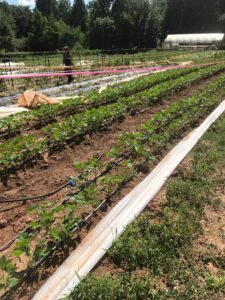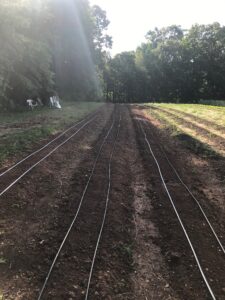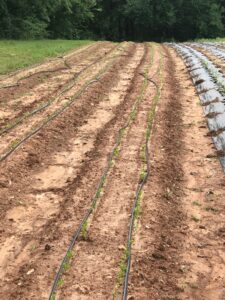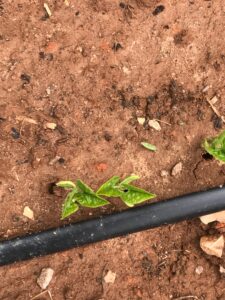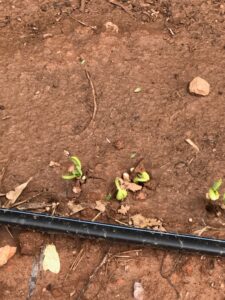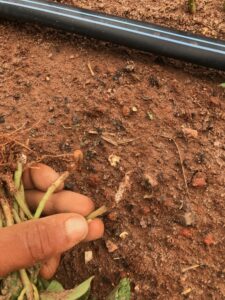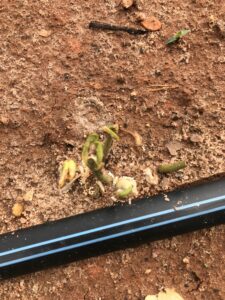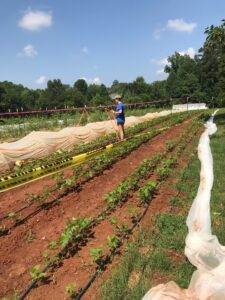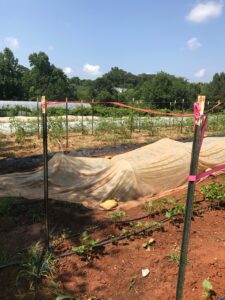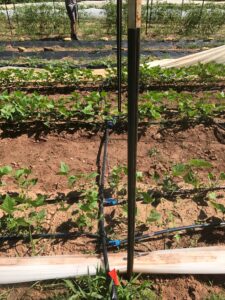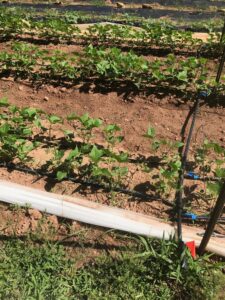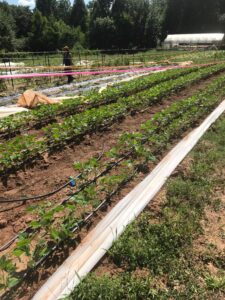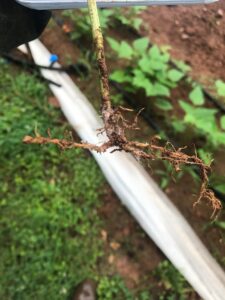Final report for FS17-303
Project Information
Southern stem blight is a fungus present in many soils across the Southeast. This fungus is responsible for the loss of many valuable vegetable crops including tomatoes, peppers, and beans. The effects of this blight occur during summer where temperatures are between 77-92 degrees. On our farm, losses are often so rapid that any action taken is too late. With crop loss comes loss of income, which is something any farmer wants to minimize as much as possible.
Many organic farmers use compost as a soil building block on the farm. On our farm we work hard on our compost creation, treating it like we would a crop. We use the compost on our farm as a way to increase sustainability, build up carbon in the soil, develop the soil’s moisture holding capacity, as a mild fertilizer, and to inoculate our fields with beneficial microbes. To maximize this resource the compost is also brewed into a tea. We create the compost tea through an aerated process with a purchased compost tea brewing machine that constantly circulates oxygen with an air pump. The aerated compost tea can be used as a foliar spray or run through our drip irrigation. Our research focuses on testing the efficacy of using compost tea as a competitive biostimulant to increase the beneficial microbial activity, which could suppress the negative activity of Southern stem blight. We believe that creating a significant competition for access to the rhizosphere of our plants will slow, and potentially inhibit, the quick spread of Southern stem blight. Research from Bulluck et al. in Organic and Synthetic Fertility Amendments (2002) and Liu et al. in Long Term Effects of Organic and Synthetic Soil (1997) has suggested that organic amendments such as compost and organic inputs, and the presence of soil microbes, such as Trichoderma spp., Bacillus subtilis, and Pencillium spp., can help suppress the infection and spread of Southern stem blight.
- A creation of a preventative practice that reduces the spread of Southern stem blight with on-farm resources
- Reduce the crop loss to Southern stem blight
- A possible increase in yield through the applications of compost tea
Cooperators
- (Educator)
- (Researcher)
Research
We proposed to run the experiment in fields we have seen damage from the blight in previous years. To make sure we would see the effects of the blight we planted Bright Lights chard in Block 1 and Red Ace beets in block 5; the locations of our two trials for the test. Both of these crops are known to be affected by Southern stem blight, if conditions are present. The Bright Lights chard saw more damage than the Red Ace beets. For an early spring planting we were surprised to see as much damage as we did. The beets saw damage only later into the season as temperatures began to warm up. Each area was 2,500 sq ft with three beds and equally divided into nine sections; however, we did not maintain our goal of no edge effects.
These locations were managed in a no-till manner; the process of turning over the area went in the order of: removing all crop residue by hand, raking any smaller material out of the field, broad forking the beds the entire length, hoeing the bed to even soil particles, then raking the bed smooth. This was a common practice on the farm. To accomplish this we only needed strip hoes, rakes, and broadforks. After preparation, we took soil samples of the area and submitted them to the county extension.
We selected the 'EZ pick' variety of bush beans to plant. Jade was not available as planned and EZ pick is a variety we chose because of heat resistance and ability to obtain years to come.
To plant these beds we used an Earthway seeder, equipped with the bush bean seed plate, and direct seeded 2 rows per bed for the 3 beds. The same seeder and plate were used for both plots to make sure similar seeding was achieved. The same day as seeding we installed new drip tape and fittings, one drip per row, and connected the system. The beans were not divided into nine subplots until after the true leaf stage in block 1 and at germination for block 5. In block 1, we did not expect to see stem blight so early, so we adjusted the dividing to subplot time to a more proper time for block 5. Once divided, the nine plots were assigned an application method in the area. To do this we placed 4 T-posts in each bed, separated every 90 feet, and strung string, tomato twine, at the top the entire length. Based on the plot, a color piece of tape was hung the length of the plot on that string; control, yellow; single treatment, pink; double treatment, orange. Once germination occurred we looked out for infected plants. We began counting once a week when signs of blight were found. Counting included two buckets to collect plants, one note pad to record the number found, and a pen. Two people usually were involved in counting the infected plants. Counting concluded the day crop residue was removed from the field, which was after the final harvest.
Applications of our farm-made compost tea occurred after the first true leaf was present on the plant. The tea was made by aerating potable water for 24 hours, placing 4 lbs of farm compost in 4 layers of 2’x1 1/2’ cheese cloth that was tied into a ball, then submerging that ball of compost into the water while tied in place with string and was allowed to brew for 24 hours. After 24 hours, we measured out the correct amount of compost tea into back sprayers, one gallon for single treatment and two gallons for double, and applied the compost tea at soil level while drip was on. The original proposal was to apply the compost tea through the drip line. This was not possible because the pressure needed to properly inject into the system was not obtainable in the 90 foot sections. The drip irrigation stayed on the entire time of treatment to make sure compost tea was worked into soil, drip was always turned on prior. The three divided plots per bed were control, single treatment, and double treatment. The control section of each bed received zero applications of compost teat throughout the entire trial. The single treatment got one gallon of compost tea applied to the 90 foot section. The double treatment had two gallons of compost tea applied to the 90 foot section. These areas were marked and remained the same throughout the trial.
The process of treatments and recording infected plants happened once a week on separate days. The data for weather was collected via National Center for Environmental Information (NCEI). Data was then entered into computer documents. A brewed batch of tea and soil samples at the end of the trials were taken to test to microbial activity.
Materials
Bed Preparation
- Broadfork
- Stirrup hoes
- Rakes
Compost tea
- Compost tea Brewer
- Cheese cloth
- Farm compost
- Clean water
- 2 Five gallon buckets
- Tomato Twine
Other materials
- Drip tape
- Drip header
- Drip connectors
- Note Pad
- Pen
- 24 Tpost
- Color tape (yellow, orange, and pink)
- Earthway seeder and bush bean plate
- EZ pick beans
- Red Ace beets
- Bright Lights Chard
The foundation of our study was using on-farm resources to combat the problem of southern stem blight. We collect vegetable scrap, pre-cooking/consumer waste, in our compost only. We do not use manures or animal by-products, except some eggshells. This vegetable material is the green for the mix and untreated sawdust from furniture manufactures on the area constitute our brown material. To create our compost tea used in the study we used this farm-made compost.The compost itself needed to be understood and what possibilities it had on helping with the study. To find this out we took samples of our compost and got a nutrient test and a biological test. The nutrient test we received came back with results of a good pH in the compost and good levels of Calcium. There was no other numbers from that seemed out of touch with normal compost. Both years yielded similar results. Sp501 SP327 The biological test was tested via the Environment Celebration Institute Inc. in 2017 and 2018. Love-is-Love-Farm-11-28-2017. 8-29-18-Love-is-Love-Farm-2018-B 8-29-18-Love-is-Love-Farm-2018-A The test was composed of a sample of compost and compost tea. The compost itself was not spread in the fields prior or during the study; however, it was the base of our tea so testing was necessary. The results of the compost itself showed a need for more biological life in our compost. The beneficial fungi needed to be increased, more protozoa, and more biological biomass overall. The tea came back with very similar result, but included the negative results of ciliate protozoan, which are not good. These results were disheartening, but the goal of this study was to use the materials we made on farm to gain a solution. So we conducted our study with this farm-made compost.
Trial 1
Trial 1 was planted on 5/27/17 and 5,643 beans germinated with an average of 627 beans per treatment replication. The first infected plants were recorded on 6/6/2017 and counting ended on 7/25/17 after the final harvest for a total of five counts. Of the 5,643 beans, 1,493 were identified as infected with southern stem blight or 26% of the entire crop which demonstrates the potential impact of southern stem blight. Of the total number of infected plants, 372 were in the control groups with an average of 19.6% of plants infected across the three treatment replications. The single treatment had 732 infected plants with a replication average of 38.9% of plants infected and the double treatment had 389 infected plants with an average of 20.7% of plants infected. The control had the lowest level of infection compared to the compost tea treatments although the double treatment had a similar but slightly higher level of blight compared to the control. The single treatment in bed 1 had the highest number of infected plants early in the season. This bed was located on the edge of the field. While this may have contributed to the increased numbers the overall highest percentage of infected beans for the single treatment was in bed 2 (47.8%) followed by bed 3 (35.6%) and bed 1 (33.3%)
Temperature and rain influence the spread of southern blight. The average high temperature for trial 1 was 86 degrees F and the average low was 70 degrees F. During the total nine week trial 11.26 inches of rain fell, giving an average of 1.25 inches a week. These conditions presented challenges for watering in the compost tea when soils were already moist. We did not see or count any losses from water related death of plants although soil moisture contributes to southern blight incidence.
Trial 1 beans were harvested once. The quality of this first harvest was low and a second harvest was not economically justifiable. A total of 183pounds of beans were harvested with 62 pounds from the control plots, 59 pounds from the single treatment plots, and 62 pounds from the double treatment. The lowest harvest totals came from the single treatment plots which also had the highest losses to southern stem blight. The double treatment harvest was similar to the control plots showing that, in this experiment, the compost tea did not increase yields or decrease blight incidence. This may be due to the low biological activity of the compost and compost tea used in the trials. Bed 1 at the edge of the field had the lowest harvest (33 lbs.) compared to 69 lbs. in bed 2 and 81 lbs. in bed 3 even though the level of stem blight was not significantly higher in bed 1 This trend was not observed in the second trial of 2017 which was planted in another field site.
Trial 2
Trial 2 was planted on 6/23/2017 and the final disease count was made on 8/18/2017. This trial had lower germination with 3,564 beans germinating or an average of 396 beans per treatment subplot. The first weekly count of infected plants occurred on 7/7/17 for a total of five counts. Of the 3,564 beans, 991 or 28% were infected with southern stem blight which is similar to the results of the first trial. Of the total number of infected plants, 355 were in the control treatment with an average of 33.2% of plants infected across the three treatment replications, 281 in the single treatment with an average of 27.2% of plants infected, and 355 in the double treatment with an average of 34.3% of plants infected across the three treatment replications. For this trial the single treatment plots had the lowest incidence of disease while the control and double treated had similar infection levels. The single treatment disease incidence was 11.7% lower than what was observed in trial 1 although there was a 20.4% increase in the trial 2 control plots and a 14.6% increase in the trial 2 double treatment plots. There was a significant difference between the treatment replications with a 41% incidence in the middle bed 2 while the beds on either side had a 25.6% (bed 1) and a 28.1% (bed 3) disease incidence. Most of the disease increase in bed 2 occurred in the control and double treatment plots. Since the subplots were randomly distributed in each bed and this increase in bed 2 did not reoccur, the increase in disease in bed 2 did not seem to indicate a trend. Overall, trial 2 had a 5% increase in disease incidence when all of the treatments were averaged (26.5% incidence in trial 1 and 31.6% in trial 2)
Southern stem blight, as the name implies, is a warm weather disease and incidence tends to increase as the temperature increases. Trial 2 was planted one month later than trial 1, and growth occurred entirely during the heat of a Georgia summer. The average high temperature during the trial was 87 degrees F and the average low was 71 degrees F. Both the low and high temperatures were one degree higher in trial 2 although the soil most likely accumulated more warmth as the summer progressed. The southern blight pathogen survives in the soil and soil temperature may be more relevant than air temperature. The total rainfall over this period was very similar to trial 1 with 11.45 inches and an average of 1.27 inches each week.
Beans were harvested three times for this trial with a total yield of 204 pounds; 68.75 lbs. for the first harvest, 52 lbs. for the second harvest, and 83.25 lbs. for the third harvest. Of the beans harvested 67 lbs. were from the control treatment, 72.25 lbs. from the single treatment, and 64.75 lbs. from the double treatment. The average number of beans harvested was 68 lbs. per harvest. This is less that the 183 lbs. from the single harvest in trial one. The lower number of bean plants certainly contributed to the decrease in yield from each harvest although overall 20 more lbs. were harvested from the trial 2 beans.
As in trial 1, there does not seem to be any clear correlation between the spraying of compost tea and a decrease in infected plants or an increase in yield. While the single treatment plots did show some reduction in disease incidence in trial 2, this effect was not observed in the other three trials.
Trial 3
Trials 3 and 4 occurred in 2018. The treatment subplots in 2018 were 60 ft. in length as opposed to 90 ft. in 2017. Trial 3 was planted on 6/22/2018 and the final disease count was made on 8/15/2018. This trial had a similar density of beans to trial 1 with 3,962 beans germinating. Disease incidence was recorded 5 times starting on 7/20/2018 and ending on 8/15/2018. Of the 3,962 beans, 1,770 were infected with southern stem blight or approximately 45% of the crop. Of the total number of infected plants, 559 were in the control treatment with an average of 45.6% of plants infected across the three treatment replications, 618 in the single treatment with an average of 44.8% of plants infected, and 593 in the double treatment with an average of 45.6% of plants infected across the three treatment replications. While the three treatments had a similar percent of infection, the replications within each treatment were variable with 55.5%, 41.3% and 39.3% of plants infected for beds 1, 2 and 3, respectively. Bed 1 stayed constantly wet during the trial due to poor soil drainage combined with frequent rains. Increases in southern blight incidence are known to be associated with poorly drained soils. Overall, the losses in trial 3 far exceeded the losses in the first two trials.
The average high and low temperatures during the trial were both two degrees higher than in trial 1 during the same period the previous year. The warm weather paired with the high rainfall totals (18 inches) very likely contributed to the increase in disease incidence in the 2018 trial 1.
Due to the high incidence of disease and the weather issues only one harvest was made. The total harvest was 72 lbs. which was low compared to harvest totals in 2017. The control plots yielded the most beans at 31 lbs., and the single and double treatments yielded 21 lbs. each.
The compost tea treatments did not appear to contribute to reduced southern blight incidence or increased harvests, although the wet weather in 2018 was a particular challenge for growers.
Trial 4
Trial 4 was the final trial of our study. Treatment subplots were again 60 ft. in length. Trial 4 was planted on 7/9/2018 and the final disease count was made on 9/7/2018. Trial 4 had the best germination with 5,312 beans. Disease incidence was recorded five times starting on 8/10. Of the germinated beans, 1,651, or 31%, were infected with southern stem blight by the end of the trial. Of the total number of infected plants, 560 were in the control treatment with an average of 29.9% of plants infected across the three treatment replications, 586 in the single treatment with an average of 32.4% of plants infected, and 505 in the double treatment with an average of 32% of plants infected across the three treatment replications. Similar to trial 3, there was little difference between treatments. However, there was less variation between treatment replications most likely because the field site for trial 4 had more consistent drainage across the beds than the field site for trial 3. Percent infection across the beds for all treatments was 26.6%, 30.2% and 37.6% for beds 1, 2 and 3, respectively. Overall, trial 4 had an average infection rate of 31.4%.
The average high temperature for trial 4 was 88.9 degrees F and the average low was 72 degrees F. These temperatures are higher than what was recorded during the second trial in 2017 but are similar to temperatures in the first trial of 2018. In addition, there were 15 inches of rain during the trial with most of the rain concentrated over the last five weeks. The higher temperatures and rainfall totals in 2018 contributed to the higher incidence of southern blight in the 2018 trial 1. Trial 2 in 2018 had a disease incidence similar to the levels observed in 2017 and the decrease in incidence compared to trial 1 2018 was most likely due to a better site drainage, better germination and a dry period during the production season.
The bean yield in trial 4 was the highest of all the trials. The higher germination rate combined with more conducive growing conditions such as rain right before flowering, little rain during flowering, and low infection incidence early in the growing season most likely contributed to increased harvests. The crop was harvested three times starting on 8/27 with a total yield of 305 lbs. which is 100 lbs. more than any previous trial and is similar to harvest totals during the spring optimum production time. The harvest from each treatment was similar with 108.5 lbs. from the control plots, 103.2 lbs. from the single treatment, and 93.82 lbs. from the double treatment. The first harvest on 8/27 had the highest yield with 163 lbs. compared to 64 and 72 lbs. for the next two harvests. As in previous trials, the compost tea treatments in trial 4 did not appear to increase harvest totals.
Overall, there was no significant decrease in disease for either of the compost tea treatments for all four trials. In addition, within treatments there was no significant variation between beds. The high levels of disease during the two years of the experiment may be associated with the highly disease conducive wet weather during the growing season and possible site conditions such as repeated planting of susceptible crops and soil drainage. During a drier year with moderate temperatures using amendments such as compost tea may have more of an effect on reducing disease.
We plant both spring and summer beans on our farm. While some losses occurred in our spring beans during the two years of the experiment the spring bean harvests were higher. The spring bean harvest in 2017 was 315 pounds, compared to that of 183 pounds in Trial 1 and 204 in Trial 2. The spring 2018 bean harvest was 372 pounds. In the summer of 2018 Trial 3 had a total harvest of 72.2 pounds and trial 4 had a harvest of 305.4 pounds. Spring beans saw a gross income of $1,302.75 in 2017 and $1,410.01 in 2018 while the summer bean income was lower. The crop loss due to southern blight does affect farm profits, and more efforts are needed to find a combination of on-farm solutions to the problem.
Raw Data for counts, harvest totals, and weather can be viewed here: https://docs.google.com/spreadsheets/d/1zv8EYg16qzjVDSZOPoCPhMVS5QZshTJD-ZMvGlvbupQ/edit?usp=sharing
Educational & Outreach Activities
Participation Summary:
Our educational tool was in collaboration with Foodwell Alliance. We had a video created that showed how to make compost tea step-by-step. We brewed the compost tea just as we did for our SARE study. This video was created to share with farmers in our area to encourage the practice of compost tea brewing. Brewing compost tea was seen as a way to maximize the creation of compost on small farms.
We had one farm tour over the two year study that farmers attended. The tour was related to the farm as a whole, but we made sure to stop and share our grant goals and practices. We did this by showing the brewer and how we make compost tea, then we would explain the way the field was organized to collect data. Lastly, we explained the process of conducting treatments. We had an open discussion for questions and explanation of results that had been collected up to that time.
Two field days were conducted on farm over the grant's life time. The first was on 7/11/17, at this event Emory at Oxford College brought two farmers and students out. During their time with us we explained the grant process, our study practice, and the goals we wanted to achieve. After a discussion and questions the group witnessed the process of our first harvest. The second event occurred on 7/9/18, we invited several farmers and agricultural professionals out to the farm. At the event we went over how we conducted the study and reviewed our resulted from the first year. We also had Brennan Washington, from SARE, speak on SARE grant opportunities and Dr. Little, from UGA and grant collaborator, speak on southern stem blight. After the presentation, we did a tour of our study plots and fielded questions.
Learning Outcomes
Compost tea
Soil Health
Project Outcomes
The results of our data did not prove our hypothesis correct; however, other results from the study will be helpful for the future. The use of our compost tea brewer and the ability to share that process with other farmers has been beneficial. Over the life of the study we only used 32 pounds of compost to treat the fields, that same amount could not cover one section of the treated subplots. The work required to produce compost is time consuming for farmers, because of that it is very important what is produced be used to its fullest capabilities. Other farmers have adopted the practice and have begun using compost tea as a way to introduce nutrients into their system. Through our compost testing, we also took a look at how to strengthen our on-farm composting program. Adding more material such as wood chips for better airflow and grading some inputs are some things we considered. The creation of quality on-farm resources is key. The best way to combat the spread of southern stem blight, advised by our collaborators, is to remove any infected plants. Through this study, and the field day we put on, we have been contemplating the benefits of pulling plants after one harvest and planting in more successions. Planting more successions would allow us to keep a steady flow of beans and the ability to pull all the potentially infected plants from the field. This idea was actually shared by one participant during a field day.
